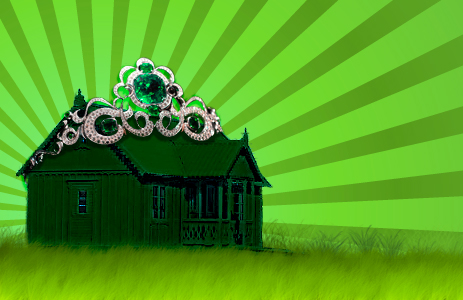
It’s pretty easy to determine the biggest pie, or longest fingernails, or fattest twins. But what about the greenest house? AOL’s consumer finance site, of all places (they’re into journalism now!) has a nice roundup of what, exactly, it means to have a green home.
There are a number of buildings that have claimed or been awarded the “greenest home” tiara:
-
A 2006 article called an eco-friendly Californa prefab the “greenest home on the planet” for being the first American home to get a “platinum” LEED rating.
[F]or Glenn, the point is to live in a home that causes the least damage to the environment. Living healthy also counts, so the paint he selected gives off next to no volatile organic compounds, and the largely steel and concrete construction inhibits mold and termites. “We’re targeting consumers who buy organic food, do yoga, and shop at Design Within Reach,” he says.
-
The Cascadia Green Building Council says the greenest home is a Vancouver house named “Eco-Sense.” Prospective builders, there’s room for improvement: Eco-Sense meets only four of the six “petals” (aw, precious!) that Cascadia uses to determine a house’s eco-friendliness.
The Bairds live in the first load-bearing code-approved cob dwelling in North America.
Solar-thermal tubes heat water, solar panels provide more electricity than they can use, and the cob walls have insulative properties conventional home builders dream of. On top of that, the house captures rainwater and filters grey water for the garden.
-
David Gottfried, founder of the U.S. Building Council (which gives out LEED ratings to efficient buildings), says the greenest home in America is owned by … David Gottfried.
Designed as a net-zero energy home, the bungalow features new Energy Star-qualified appliances; low-E, double-pane windows; cellulose wall insulation; photovoltaic panels, and a solar water heater.
Its dual-flush toilets and low-flow showerheads and faucet aerators help the family consume less water.
-
The Atlantic profiled a husband and wife who say they’re trying to build the world’s greenest home. It has a lot of green-tech bells and whistles, but its gigantic size detracts a little from the goal.
The couple’s 5,600-square-foot home will be outfitted with a host of aggressively eco-friendly technologies and materials: a recycled-steel roof that diverts rainwater to a 50,000-gallon underground cistern; reclaimed stone left over from the construction of Chicago skyscrapers; solar panels powerful enough to provide electricity to the home, charge five electric cars, and still return energy to the grid; a cedar interior cut from sustainable forests (where trees are selectively harvested to minimize environmental damage); doors and windows of Portuguese eucalyptus approved by the Forest Stewardship Council; oak floors salvaged from old granaries; recycled-glass sinks; a recycled-steel kitchen hood.
The conspicuous consumerism of that last home — did we mention its temperature and lighting can be controlled by iPad? — points to a distressing trend in houses competing for the label of Greenest in Show. Sometimes they’re less about sustainability, more about showmanship.
Solar panels and other features let some trendy houses produce enough of their own energy that they actually sell power back to the energy company, which is nifty. Yet a person vying to live in the world’s “greenest” house could theoretically load it up with big-screen TVs and other less-than-efficient appliances, then write a mega-check to put solar panels all over the roof. But the resources consumed would belie the “green” label.
This “greenest house” thing is sort of a pointless race — not unlike having the longest fingernails, actually — since these green-tech-heavy yuppie paradises aren’t likely to be more energy-efficient than a hut in a village.
In the end, the world’s greenest home … very likely is: a) not in North America, Europe or industrialized parts of Asia; b) not advertised as “the greenest” because the person living there isn’t thinking about that; c) probably very modest in size, relative to square footage per person, and probably uses natural materials and a vernacular design instead of being a so-called “international style” of building; d) probably in a rural area.
On the up side, it’s better than having people vie for “Most Massive Car.”




